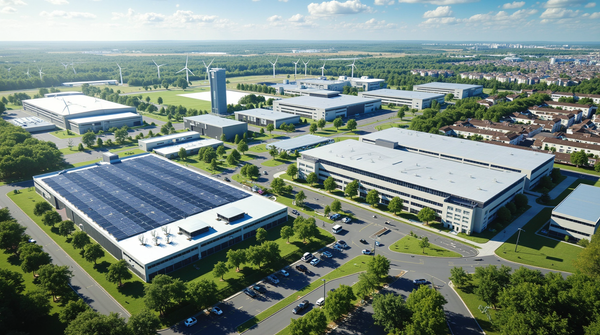From Producer to Consumer: Mapping Energy Market Players

In a world where energy issues have never been so crucial, one question persists: how can we ensure a fairer, more sustainable and transparent energy market? 🌍 From production to consumption, the energy path is punctuated by players, decisions and challenges. Yet, for the end consumer, this path often remains unclear. Who produces the energy we use? How is it transported and distributed? And above all, how can citizens ensure that they are participating in a fair and ecological system?
Today, let's take a look at the map of energy market players in Europe, and explore innovative solutions for bringing producers and consumers closer together.
A complex but necessary chain
The energy market is a chain of players: producers, transporters, distributors, suppliers and, of course, consumers. At each stage, strategic choices are made, impacting energy costs, quality and sustainability. But this system, though efficient on paper, is sometimes criticized for its opacity.
In 2022, a study conducted by the European Union revealed that 68% of European citizens do not clearly understand how their energy is produced or where it comes from. This lack of transparency is an obstacle to an inclusive energy transition. However, a number of initiatives are beginning to change this.
The structure of the energy market
The energy market is organized around a complex value chain, in which each player plays a specific and essential role:
- Energy producers: They operate power plants (nuclear, thermal, hydraulic) and renewable energy facilities (wind, solar). Their role is to generate electricity for the grid.
- Transmission system operators (TSOs): In France, RTE manages the high-voltage lines that carry electricity over long distances. They ensure a constant balance between production and consumption.
- Distribution network operators (GRD): Like Enedis in France, they manage the medium- and low-voltage network that carries electricity to end consumers. They are responsible for connection, troubleshooting and metering.
- Energy suppliers: They buy electricity on wholesale markets and sell it to end consumers. They manage customer relations and billing, and offer a range of tariffs.
Energy is traded on several markets:
- The wholesale market: where producers sell their electricity to suppliers, with short-term (spot market) or long-term transactions.
- The balancing market: Managed by the TSO to ensure real-time balance between supply and demand.
- The retail market: where suppliers sell electricity to end consumers.
This complex organization is designed to guarantee a reliable, uninterrupted supply of electricity, while ensuring healthy competition between market players.
New challenges and players on the power grid
Faced with the massive electrification of our uses (electric vehicles, heat pumps, etc.), the power grid is facing unprecedented challenges. Daily consumption peaks are becoming more intense and more frequent, putting existing infrastructures to the test.
Current network challenges
- Local saturation: Some areas of the network reach their capacity limits, particularly during periods of high demand.
- Peak load management: Consumption peaks, particularly in the evening, require greater network flexibility.
- Integration of renewable energies: The intermittency of renewable energies makes balancing the grid more complex.
Emergence of new players
To meet these challenges, new players are emerging on the energy scene:
- Load shedding aggregators: They pool and leverage consumers' flexibility to relieve the grid at critical times.
- Energy communities: These structures enable energy to be shared locally between producers and consumers in the same neighborhood.
- Storage operators: They develop and manage storage solutions (batteries, hydrogen) to absorb surpluses and make up for shortfalls.
Let's take a closer look at the role of these three emerging players in the new energy landscape:
1. Erasure aggregators
These players play a crucial role in optimizing energy consumption. Examples of notable companies:
- Next Kraftwerke (Germany) - Virtual power plant operator
- Voltalis (France) - Leader in residential load shedding
- Energy Pool (France) - Industrial load shedding specialist
- REstore (Belgium) - Now part of Centrica Business Solutions
- Flexitricity (UK) - Demand-response pioneer
2. Energy communities
These structures facilitate the local sharing of energy between producers and consumers. Notable examples:
- WeSmart (France/Belgium) - Innovative solutions for optimizing and sharing energy in local communities
- Som Energia (Spain) - Green energy citizen cooperative
- Energie Samen (Netherlands) - Federation of energy cooperatives
- Bürgerwerke (Germany) - Network of citizen energy communities
- Energy4All (UK) - Community project facilitator
3. Storage operators
These players are developing solutions to manage energy surpluses and deficits. Examples of innovative companies:
- Neoen (France) - Developer of large-scale solar and storage projects
- Sonnen (Germany) - Residential storage specialist
- HDF Energy (France) - Hydrogen storage pioneer
- RES (United Kingdom) - Developer of integrated storage solutions
This evolution is shifting the traditional centralized model towards a more distributed system, where local energy management is becoming increasingly important. Grid operators must now work closely with these new players to orchestrate this transformation.
Local initiatives that make a difference
Energy cooperatives, for example, are a direct response to this problem. In Germany, over 900 energy cooperatives enable citizens to produce their own renewable energy and share it with their community. The result? Lower costs for members and greater independence from large, traditional suppliers. 💡
Finally, on a European scale, digital platforms are emerging to directly connect producers and consumers. These tools not only provide greater price transparency, but also encourage the use of renewable energies. This is a promising step forward for a market often criticized for its lack of flexibility.
Encouraging participatory governance
Another essential lever lies in involving consumers in energy market decisions. Why not include citizens in strategic discussions? 📊 In Belgium, "citizens' assemblies" for the climate have been set up, where participants debate and propose concrete solutions for their region. These initiatives build trust and enable the co-creation of policies tailored to the real needs of local residents.
In addition, European governments are increasingly investing in educational tools to raise awareness among the general public. Campaigns like "Clean Energy for All Europeans" aim to simplify complex information and encourage informed choices.
Conclusion: What role will you play?
The energy path, from producer to consumer, is undergoing radical change. Solutions exist to make this market more transparent, fair and sustainable. But to go further, every player, including you, can play a key role.
What do you think of these initiatives? Are you ready to get more involved in your country's energy transition? Share your ideas and let's become agents of change together. 🌱



